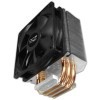- Qualcomm Launches Snapdragon 4 Gen 2 Mobile Platform
- AMD Launches Ryzen PRO 7000 Series Mobile & Desktop Platform
- Intel Launches Sleek Single-Slot Arc Pro A60 Workstation Graphics Card
- NVIDIA Announces Latest Ada Lovelace Additions: GeForce RTX 4060 Ti & RTX 4060
- Maxon Redshift With AMD Radeon GPU Rendering Support Now Available
OCZ CPU Cooler Roundup

OCZ is well known for their memory and power supplies, but we thought we’d see just how well their current fleet of CPU coolers held up. We pit the Vendetta, Vendetta 2, Vanquisher and even the old-school Vindicator against our QX6850 to see what each one is made of.
Page 1 – Introduction
|
|
Heatpipes have sure come a very long way in a very short time. That is what we are seeing in today’s heatsink world, and for good reason. It’s a wonderful and highly versatile cooling device. How it functions is simple in theory also. A very small amount of proprietary liquid trapped inside a copper pipe transfers all the heat from the base to the top where the fan can do its job in conjunction with either copper or aluminum fins to keep your processor from melting.
Today, we are taking a look at four different CPU coolers from OCZ – a company that is a relatively new, but have already developed themselves into a name that’s synonymous with “enthusiast”. They have produced some world-leading memory, many top-tier PSUs (especially now that they’ve acquired PCP&C) and of course, CPU coolers. Since they had more than one CPU cooler available, we thought we’d pit all four of their current models against each other and see which came out on top.
Whether you are looking for silence or that last 10MHz out of your CPU, you will most likely want to run an aftermarket CPU cooler. The stock Intel heatsink does work well enough for some people, but I for one am not one of those people. Also, with the availability of OEM processors which do not come with a stock sink, you will be shopping for one along with that CPU purchase.
Closer Look
The coolers we are looking at today are OCZ’s Vanquisher, Vendetta, Vendetta 2 and the Vindicator. Each one is geared towards a different part of the market. It was our goal to see how each one could handle our hot Intel Core 2 Extreme QX6850.
When placed side by side, it’s relatively easy to see differences, and we can see that each one takes a different approach to do the same job. The fan size is the first main difference, with the Vanquisher using an 80mm, the Vendetta a 92mm, the Vendetta 2 a larger 120mm and the Vanquisher also with a silent 120mm fan. The first 3 are PWM 4 wire fans allowing your motherboard to control the speed while the Vindicator sticks to a regular quiet 3-pin fan connector.
There are also striking differences in the mounting surface. The Vanquisher and both Vindicator have a smooth copper mounting surface while the Vendetta models take a unique approach by placing the heat pipes directly on the CPU surface.
Mounting them on our Intel test bed was simple thanks to the OEM-style push-pin mounting brackets. While not pictured, I should mention that they all come with appropriate hardware for AMD AM2 use as well.
Time to put some fire under these guys and see where they stand. Below are the specs for our test-bed used here. Other upcoming CPU cooler roundups will stick to the same test-bed. We chose rather lightweight components, aside from the CPU, in order to keep the motherboard surface area as cool as possible during our stress-tests.
- Motherboard: ASUS P5E3 Deluxe WiFi
- CPU: Intel C2E QX6850
- Ram: OCZ Platinum PC3-1333 2X1GB
- Video: ASUS 6200 PCI-E
- PSU: Enermax Liberty 400W
- Hard Drive / ODD: Western Digital 80GB IDE
- Operating System: Windows XP Professional 32-bit
Each heatsink was tested using PRIME95 stress test with CPU-Z and CoreTemp recording all the vital signs. Each test was run for a full 2 hours to build up the heat load and afterwards, the results were recorded. Ambient room temperature was kept to a nearly constant 67°F – 69&def;F, with no other cooling devices located near our PC.
Once done testing with one heatsink, we allowed the CPU to cool down for one hour in order to remove any residual heat. OCZ Freeze thermal compound is our TIM of choice, and was used between all four heatsinks.
Testing results
I tested all 4 heatsinks with the exact same settings thanks to ASUS’ OC Profile’s option in the BIOS to ensure that the settings for each level of overclock were identical. The CPU voltage had to be set to 1.4125v in the BIOS for our 3.67GHz settings, but stock voltages were set to Auto for both stock and 3.33GHz. I only changed the CPU multiplier to overclock the CPU so that there were as few variables as possible throughout testing. All fans were run at their maximum RPM at all times.


Each cooler here gave us some interesting results to deal with. I’ll discuss the pros and cons of each cooler on the following page.
|
|
Support our efforts! With ad revenue at an all-time low for written websites, we're relying more than ever on reader support to help us continue putting so much effort into this type of content. You can support us by becoming a Patron, or by using our Amazon shopping affiliate links listed through our articles. Thanks for your support!




